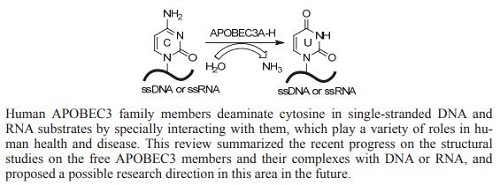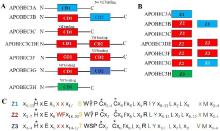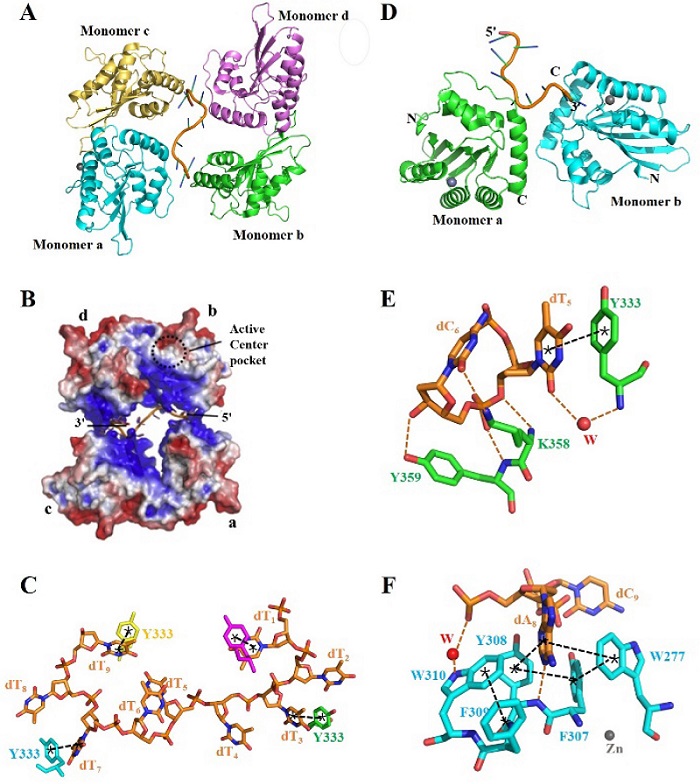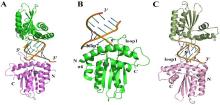化学学报 ›› 2019, Vol. 77 ›› Issue (11): 1089-1098.DOI: 10.6023/A19080296 上一篇 下一篇
综述
金交羽ab, 严小璇b, 刘亚平b, 蓝文贤b, 王春喜b, 许斌a*( ), 曹春阳b*(
), 曹春阳b*( )
)
投稿日期:2019-08-07
发布日期:2019-08-15
通讯作者:
许斌,曹春阳
E-mail:xubin@t.shu.edu.cn;ccao@mail.sioc.ac.cn
作者简介:金交羽, 女, 上海大学和中科院上海有机所2017级联合培养在读硕士研究生, 主要研究方向为APOBEC3胞嘧啶脱氨基化酶的结构与机理|许斌, 男, 上海大学化学系教授、博导. 2000年获中国科学院上海有机化学研究所理学博士(导师:麻生明院士); 2000~2002年, 在美国国立卫生研究院(NIH)进行博士后研究, 从事基于嘌呤受体的激动剂和拮抗剂的设计与合成(导师: K. A. Jaconson). 2002~2005年, 于美国VivoQuest公司担任高级研究员, 从事抗丙型肝炎药物的设计和合成; 2005年底加入上海大学化学系; 2007年入选上海市“浦江人才”计划.曾获宝钢优秀教师奖、ACP Advanced Research Network Lectureship Award、Asia Core Program Lectureship Award等荣誉.研究方向: (1)惰性化学键可控转化; (2)新型药物分子的设计与合成|曹春阳, 男, 1970年8月出生. 2001年博士毕业于中国科学院上海有机化学研究所, 随后在美国约翰霍普金斯大学医学院做博士后与研究助理, 2005年12月至2006年08月, 转至美国Salk生物研究院结构生物学中心做助理研究员.现任中国科学院上海有机化学研究所“百人计划”研究员, 是上海市“浦江计划”获得者.研究方向:以健康与疾病导向的、以NMR为主要技术手段的化学生物学与结构生物学.内容包括: (1)与癌症或者HIV病毒感染等相关蛋白质与核酸特异性作用机制与功能研究; (2)以与癌症或者HIV病毒感染等相关核酸或蛋白质为靶标, 进行药物分子设计与筛选; (3)基于核磁共振波谱学的蛋白质高效表达新技术新方法研究.
基金资助:
Jin Jiaoyuab, Yan Xiaoxuanb, Liu Yapingb, Lan Wenxianb, Wang Chunxib, Xu Bina*( ), Cao Chunyangb*(
), Cao Chunyangb*( )
)
Received:2019-08-07
Published:2019-08-15
Contact:
Xu Bin,Cao Chunyang
E-mail:xubin@t.shu.edu.cn;ccao@mail.sioc.ac.cn
文章分享

载脂蛋白B mRNA催化编辑蛋白APOBEC3(简称为A3)是细胞内逆转录转座子防御系统中一类家族蛋白,它通过对底物单链DNA和RNA中胞嘧啶的脱氨基化在人类的健康和疾病中发挥多种多样的作用.部分人源A3家族蛋白通过对病毒基因组中的胞嘧啶脱氨基化产生尿嘧啶,使逆转录病毒人类免疫缺陷病毒(HIV-1)基因组发生G→A碱基突变,致使HIV-1基因组不能执行正常的功能而抑制HIV-1病毒复制.作为反保护措施,HIV-1病毒利用自身的Vif蛋白(viral infectivity factor)结合人源A3蛋白,通过泛素化标记使A3蛋白降解,从而保证病毒感染.为更好理解A3蛋白催化胞嘧啶脱氨基化机制及抗病毒机制,综述了A3家族蛋白结构、它们对DNA或者RNA进行脱氨基化反应特点和它们与核酸复合物结构的研究进展,对A3家族蛋白参与脱氨基化反应的关键残基如何与核酸碱基相互作用等作了简单概括,相互作用的共同特征进行简要总结,对后期如何利用冷冻电镜技术开展全长A3蛋白相关工作做了展望.本文也部分讨论了A3蛋白如何与Vif相互作用,因此本综述对针对这些相互作用合理设计抗病毒药物有一定帮助.
金交羽, 严小璇, 刘亚平, 蓝文贤, 王春喜, 许斌, 曹春阳. 胞嘧啶脱氨基化酶APOBEC3家族及其与核酸复合物结构研究进展[J]. 化学学报, 2019, 77(11): 1089-1098.
Jin Jiaoyu, Yan Xiaoxuan, Liu Yaping, Lan Wenxian, Wang Chunxi, Xu Bin, Cao Chunyang. Recent Advances in the Structural Studies on Cytosine Deaminase APOBEC3 Family Members and Their Nucleic Acid Complexes[J]. Acta Chimica Sinica, 2019, 77(11): 1089-1098.


















| [1] |
Goila-Gaur R.; Strebel K. Retrovirology 2008, 5, 51.
doi: 10.1186/1742-4690-5-51 |
| [2] |
Larue R. S.; Andresdottir V.; Blanchard Y.; Conticello S. G.; Derse D.; Emerman M.; Greene W. C.; Jonsson S. R.; Landau N. R.; Lochelt M.; Malik H. S.; Malim M. H.; Munk C.; O'Brien S. J.; Pathak V. K.; Strebel K.; Wain-Hobson S.; Yu X. F.; Yuhki N.; Harris R. S. J. Virol. 2009, 83, 494.
doi: 10.1128/JVI.01976-08 |
| [3] |
Wedekind J. E. Trends Genet. 2003, 19, 207.
doi: 10.1016/S0168-9525(03)00054-4 |
| [4] |
Harris R. S.; Liddament M. T. Nat. Rev. Immunol. 2004, 4, 868.
doi: 10.1038/nri1489 |
| [5] |
Kitamura S.; Ode H.; Nakashima M. Nat. Struct. Mol. Biol. 2012, 19, 1005.
doi: 10.1038/nsmb.2378 |
| [6] |
Mitra M.; Hercik K.; Byeon I. J. L. Nucleic Acids Res. 2014, 42, 1095.
doi: 10.1093/nar/gkt945 |
| [7] | Chen K. M.; Harjes E.; Gross P. J.; Fahmy A.; Lu Y.; Shindo K. Seibutsu Butsuri 2008, 48, 116 |
| [8] |
Burns M. B.; Lackey L.; Carpenter M. A.; Rathore A.; Land A. M.; Leonard B. Nature 2013, 494, 366.
doi: 10.1038/nature11881 |
| [9] |
Shi K.; Carpenter M. A.; Kurahashi K.; Harris R. S.; Aihara H. J. Biol. Chem. 2015, 290, 28120.
doi: 10.1074/jbc.M115.679951 |
| [10] |
Xiao X.; Yang H.; Arutiunian V.; Fang Y.; Chen X. S. Nucleic Acids Res. 2017, 45, 7494.
doi: 10.1093/nar/gkx362 |
| [11] |
Nathans R.; Cao H.; Sharova N.; Ali A.; Sharkey M.; Stranska R. Nat. Biotechnol. 2008, 26, 1187.
doi: 10.1038/nbt.1496 |
| [12] |
Dang Y.; Wang X.; Esselman W. J.; Zheng Y. H. J. Virol. 2006, 80, 10522.
doi: 10.1128/JVI.01123-06 |
| [13] |
Stanley B. J.; Ehrlich E. S.; Short L.; Yu Y.; Xiong Y. J. Virol. 2008, 82, 8656.
doi: 10.1128/JVI.00767-08 |
| [14] |
Seplyarskiy V. B.; Andrianova M. A.; Bazykin G. A. Genome Res. 2017, 27, 175.
doi: 10.1101/gr.210336.116 |
| [15] |
Zheng Y. H.; Irwin D.; Kurosu T. J. Virol. 2004, 78, 6073.
doi: 10.1128/JVI.78.11.6073-6076.2004 |
| [16] |
Byeon I. J. L.; Ahn J.; Mitra M.; Byeon C. H.; Hercík K.; Hritz J. Nat. Commun. 2013, 4, 1890.
doi: 10.1038/ncomms2883 |
| [17] | Chelico L.; Prochnow C.; Erie D. A. J. Biol. Chem. 2010, 283, 16195 |
| [18] |
Guo Y.; Dong L.; Qiu X.; Wang Y.; Zhang B.; Liu H. Nature 2014, 505 7482 229.
doi: 10.1038/nature12884 |
| [19] |
Bohn M. F. Structure 2013, 21, 1042.
doi: 10.1016/j.str.2013.04.010 |
| [20] |
Siu K. K.; Sultana A.; Azimi F. Nat. Commun. 2013, 4, 2593.
doi: 10.1038/ncomms3593 |
| [21] |
Matsui M.; Shindo K.; Izumi T.; Io K.; Shinohara M.; Komano J.; Kobayashi M.; Kadowaki N.; Harris R. S.; Takaori-Kondo A. Virol. J. 2014, 11, 122.
doi: 10.1186/1743-422X-11-122 |
| [22] |
Kouno T.; Luengas E. M.; Shigematsu M. Nat. Struct. Mol. Biol. 2015, 22 6 485.
doi: 10.1038/nsmb.3033 |
| [23] |
Klarmann G. J. J. Biol. Chem. 2003, 278, 7902.
doi: 10.1074/jbc.M207223200 |
| [24] |
Furukawa A.; Nagata T.; Matsugami A. Nucleic Acids Symp. Ser. 2009, 53, 87.
doi: 10.1093/nass/nrp044 |
| [25] | Mangeat B.; Turelli P.; Caron G.; Friedli M.; Perrin L.; Trono D. Nature 2003, 4244, 99 |
| [26] |
Peng G. J. Exp. Med. 2006, 203, 41.
doi: 10.1084/jem.20051512 |
| [27] |
Chelico L.; Pham P.; Calabrese P.; Goodman M. F. Nat. Struct. Mol. Biol. 2006, 13, 392.
doi: 10.1038/nsmb1086 |
| [28] |
Harjes E.; Gross P. J.; Chen K. M.; Lu Y.; Shindo K. J. Mol. Biol. 2009, 389, 819.
doi: 10.1016/j.jmb.2009.04.031 |
| [29] | Wichroski M. J. K. Ichiyama; T. M. Rana. J. Biol. Chem. 2005, 280, 8387 |
| [30] |
Sheehy A. M.; Gaddis N. C.; Choi J. D.; Malim M. H. Nature 2002, 418, 646.
doi: 10.1038/nature00939 |
| [31] |
Bennett R. P.; Presnyak V.; Wedekind J. E.; Smith H. C. J. Biol. Chem. 2008, 283, 7320.
doi: 10.1074/jbc.M708567200 |
| [32] |
Lu X.; Zhang T. L.; Xu Z. J. Biol. Chem. 2015, 290, 4010.
doi: 10.1074/jbc.M114.624262 |
| [33] |
Dang Y.; Siew L. M.; Wang X. J.; Han Y. X.; Lampen R.; Zheng Y. H. J. Biol. Chem. 2008, 283, 11606.
doi: 10.1074/jbc.M707586200 |
| [34] |
Jarmuz A.; Chester A.; Bayliss J.; Gisbourne J.; Dunham I.; Scott J. Genomics 2002, 79, 285.
doi: 10.1006/geno.2002.6718 |
| [35] |
Holden L. G.; Prochnow C.; Chang Y. P. Nature 2008, 456, 121.
doi: 10.1038/nature07357 |
| [36] |
Olson M. E.; Li M.; Harris R. S. Chem. Med. Chem. 2013, 8, 112.
doi: 10.1002/cmdc.201200411 |
| [37] |
Jager S.; Kim D. Y.; Hultquist J. F.; Shindo K.; Larue R. S.; Kwon E. Nature 2012, 481, 371.
doi: 10.1038/nature10693 |
| [38] |
Mehle A.; Strack B.; Ancuta P.; Zhang C.; Mcpike M.; Gabuzda D. J. Biol. Chem. 2004, 279, 7792.
doi: 10.1074/jbc.M313093200 |
| [39] |
Marcsisin S. R.; Engen J. R. J. Mol. Biol. 2010, 402, 892.
doi: 10.1016/j.jmb.2010.08.026 |
| [40] |
Bergeron J. R.; Huthoff H.; Veselkov D. A.; Beavil R. L.; Sanderson M. R. PLoS Pathog. 2010, 6, e1000925.
doi: 10.1371/journal.ppat.1000925 |
| [41] |
Reingewertz T. H.; Shalev D. E.; Friedler A. Protein Pept. Lett. 2010, 17, 988.
doi: 10.2174/092986610791498876 |
| [42] |
Liddament M. T.; Brown W. L.; Schumacher A. J.; Harris R. S. Curr. Biol. 2004, 14, 1385.
doi: 10.1016/j.cub.2004.06.050 |
| [43] |
Lu Z.; Bergeron J. R. C.; AtkinsLu Z.; Bergeron J. R. C.; Atkinson R. A.; Schaller T.; Veselkov D. A.; Oregioni A. Open. Biol. 2013, 3, 130100.
doi: 10.1098/rsob.130100 |
| [44] |
Luo K.; Xiao Z.; Ehrlich E.; Yu Y.; Liu B.; Zheng S. Proc. Natl. Acad. Sci. U. S. A. 2005, 102, 11444.
doi: 10.1073/pnas.0502440102 |
| [45] |
Stenglein M. D.; Burns M. B.; Li M.; Lengyel J.; Harris R. S. Nat. Struct. Mol. Biol. 2010, 17, 222.
doi: 10.1038/nsmb.1744 |
| [46] |
Chelico L.; Pham P.; Calabrese P.; Goodman M. F. Nat. Struct. Mol. Biol. 2006, 13, 392.
doi: 10.1038/nsmb1086 |
| [47] |
Ronsard L.; Raja R.; Panwar V.; Saini S.; Mohankumar K.; Sridharan S. Sci. Rep. 2015, 5, 15438.
doi: 10.1038/srep15438 |
| [48] |
Yamanaka S.; Balestra M. E.; Ferrell L. D. Proc. Nat. Acad. Sci. U. S. A. 1995, 92, 8483.
doi: 10.1073/pnas.92.18.8483 |
| [49] |
Navarro F.; Bollman B.; Chen H. Virology 2005, 333, 374.
doi: 10.1016/j.virol.2005.01.011 |
| [50] |
Kouno T.; Silvas T. V.; Hilbert B. J.; Shandilya S. M. D.; Bohn M. F.; Kelch B. A.; Royer W. E.; Somasundaran M.; Kurt Yilmaz N.; Matsuo H.; Schiffer C. A. Nat. Commun. 2017, 8, 15024.
doi: 10.1038/ncomms15024 |
| [51] |
Shi K.; Carpenter M. A.; Banerjee S.; Shaban N. M.; Kurahashi K.; Salamango D. J.; McCann J. L.; Starrett G. J.; Duffy J. V.; Demir O.; Amaro R. E.; Harki D. A.; Harris R. S.; Aihara H. Nat. Struct Mol. Biol. 2017, 24, 131.
doi: 10.1038/nsmb.3344 |
| [52] |
Fang Y.; Xiao X.; Li S.; Wolfe A.; Chen X. S. J. Mol. Biol. 2018, 430, 87.
doi: 10.1016/j.jmb.2017.11.007 |
| [53] |
Cheng C.; Zhang T.; Wang C. X.; Lan W.; Ding J.; Cao C. Y. Chin. J. Chem. 2018, 36, 1241.
doi: 10.1002/cjoc.201800508 |
| [54] |
Xiao X.; Li S. X.; Yang H.; Chen X. S. Nat. Commun. 2016, 7, 12193.
doi: 10.1038/ncomms12193 |
| [55] |
Maiti A.; Myint W.; Kanai T.; Delviks-Frankenberry K.; Sierra Rodriguez C.; Pathak V. K.; Schiffer C. A.; Matsuo H. Nat. Commun. 2018, 9, 2460.
doi: 10.1038/s41467-018-04872-8 |
| [56] |
Yan X. X.; Lan W. X.; Wang C. X.; Cao C. Y. Chem. Asian J. 2019, 14, 2235.
doi: 10.1002/asia.201900480 |
| [57] |
Bohn J. A.; Thummar K.; York A.; Raymond A.; Brown W. C.; Bieniasz P. D.; Hatziioannou T.; Smith J. L. Nat. Commun. 2017, 8, 1021.
doi: 10.1038/s41467-017-01309-6 |
| [58] |
Nadine M. S.; Shi K.; Lauer K. V.; Brown W. L.; Aihara H.; Harris R. S. Mol. Cell 2018, 69, 75.
doi: 10.1016/j.molcel.2017.12.010 |
| [59] |
Matsuoka T.; Nagae T.; Ode H.; Awazu H.; Kurosawa T.; Hamano A.; Matsuoka K.; Hachiya A.; Imahashi M.; Yokomaku Y.; Watanabe N.; Iwatani Y. Nucleic Acids Res. 2018, 46, 10368
doi: 10.1093/nar/gky676 |
| [1] | 刘洋, 高丰琴, 马占营, 张引莉, 李午戊, 侯磊, 张小娟, 王尧宇. 一例钴基金属有机框架化合物活化过氧单硫酸盐高效降解水中亚甲基蓝研究[J]. 化学学报, 2024, 82(2): 152-159. |
| [2] | 曾如馨, 陈鹏. RNA结合蛋白的组学解析与功能探索★[J]. 化学学报, 2024, 82(1): 53-61. |
| [3] | 张凯, 武晓君. 具有室温铁磁性的二维Janus钛硫属化物★[J]. 化学学报, 2023, 81(9): 1142-1147. |
| [4] | 张正初, 熊炜, 吕华. α-螺旋聚氨基酸交联的水凝胶的制备和材料特性★[J]. 化学学报, 2023, 81(9): 1113-1119. |
| [5] | 杨蓉婕, 周璘, 苏彬. 基于共价有机框架修饰电极的维生素A和C的选择性检测★[J]. 化学学报, 2023, 81(8): 920-927. |
| [6] | 崔国庆, 胡溢玚, 娄颖洁, 周明霞, 李宇明, 王雅君, 姜桂元, 徐春明. CO2加氢制醇类催化剂的设计制备及性能研究进展[J]. 化学学报, 2023, 81(8): 1081-1100. |
| [7] | 刘嘉文, 林玮璜, 王惟嘉, 郭学益, 杨英. Cu1.94S-SnS纳米异质结的合成及其光催化降解研究[J]. 化学学报, 2023, 81(7): 725-734. |
| [8] | 刘佳, 陈光海, 陈轶群, 江杰涛, 肖霄, 吴强, 杨立军, 王喜章, 胡征. 碳热还原活化扩孔提升介观结构碳纳米笼超级电容器性能★[J]. 化学学报, 2023, 81(7): 709-716. |
| [9] | 张玉莹, 蔡潇, 胡维刚, 李光俊, 祝艳. Pd和Hg共掺杂的金属纳米团簇HgPdAu23(PET)18★[J]. 化学学报, 2023, 81(7): 703-708. |
| [10] | 梁雪峰, 荆剑, 冯昕, 赵勇泽, 唐新员, 何燕, 张立胜, 李慧芳. 共价有机框架COF66/COF366的电子结构: 从单体到二维平面聚合物[J]. 化学学报, 2023, 81(7): 717-724. |
| [11] | 胡立伟, 刘宪虎, 刘春太, 宋延林, 李明珠. 光子晶体结构色材料的自组装制备与应用★[J]. 化学学报, 2023, 81(7): 809-819. |
| [12] | 陈剑, 蔡卓尔, 焦淑琳, 张祥, 胡进忠, 刘敏, 孙伯旺, 花秀妮. 一种热响应介电开关型零维有机-无机杂化材料: (C3H6NH2)2CoCl4[J]. 化学学报, 2023, 81(5): 480-485. |
| [13] | 贾洋刚, 陈诗洁, 邵霞, 程婕, 林娜, 方道来, 冒爱琴, 李灿华. 高性能无钴化钙钛矿型高熵氧化物负极材料的制备及储锂性能研究[J]. 化学学报, 2023, 81(5): 486-495. |
| [14] | 宁聪聪, 杨倩, 毛阿敏, 唐梓嘉, 金燕, 胡宝山. 石墨烯纳米带的可控制备研究进展[J]. 化学学报, 2023, 81(4): 406-419. |
| [15] | 刘金晶, 杨娜, 李莉, 魏子栋. 铂活性位空间结构调控氧还原机理的理论研究★[J]. 化学学报, 2023, 81(11): 1478-1485. |
| 阅读次数 | ||||||
|
全文 |
|
|||||
|
摘要 |
|
|||||